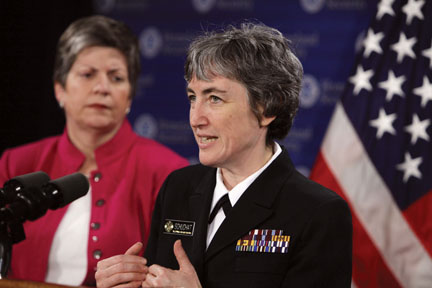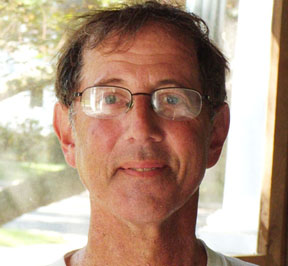Disease Detective
When potential pandemics appear, Anne Schuchat ’80 springs into action.

Anne Schuchat (right) joins Homeland Security Secretary Janet Napolitano during a late April news briefing on government response to swine flu. Schuchat is the interim deputy director for the Science and Public Health Program at the Centers for Disease Control and a rear admiral in the Office of the Surgeon General.
It was mid-April at the Centers for Disease Control (CDC), just about the time to start breathing a little more easily now that the flu season had passed without any big problems. Then there were reports of two apparently unrelated cases of children in California falling ill with an odd strain of influenza.
“That’s when you have to start acting like a detective,” says Anne Schuchat, a scientist and physician at the CDC currently serving as interim deputy director for the Science and Public Health Program. “Is this a real problem, or just a false alarm? You have to get right on it and find out.”
The CDC labs took aim at the viruses and found them to be the same. They turned to Schuchat, who at that moment became the public point person for H1N1 (the medical designation for swine flu). Wearing naval garb—she also is a rear admiral because the Office of the Surgeon General, to which she belongs, uses military titles—she has been the major governmental spokeswoman to both raise awareness and calm jitters about the potential pandemic.
“We activated our emergency system within five days and had our first press briefing on April 23,” says Schuchat. “We didn’t know then whether this was something or nothing, but within days, we found that there was more respiratory disease than normal in Mexico and were glad we had gotten started.”
Schuchat has spent a career in infectious disease and the public-health response to it. At the CDC, where she has worked since 1988, she was a leader in the response team to the SARS epidemic in 2003 and has spent much of the years since working with both researchers and public health officials to develop emergency response standards for cases just like the current H1N1 crisis.
“The nature of epidemiology and the public health response involves questioning the information and applying lessons learned from the experience,” says Schuchat. “With SARS in 2003, we learned that it was a totally new disease and that there was going to be a great economic impact because of the limits imposed on trade and travel.
“It was a challenging problem in the countries where there was a major spread, but there was an aggressive public-health response that didn’t take a long time,” she says. “I am convinced that there has to be that aggressiveness. It may have been unfortunate that we had to quarantine people who didn’t have the disease, but pandemics don’t go away on their own.”
By late spring, H1N1 seemed to have subsided, but Schuchat says she was unworried about accusations that its danger had been hyped either by the media or health officials. Bennett Lorber ’64, a professor of medicine and infectious diseases at Temple University who describes himself as a friend and fan of Schuchat, says her response was right on.
“My wife and I had been watching news reports and thought they were inflammatory,” says Lorber. “Then one night we saw the Lehrer show, and there was Anne, dispassionately discussing what was known, with measured words and clear instructions. When it was over, my wife said, ‘I feel a lot better that the people in charge know what they are doing’.”
Schuchat warns that it is far too early to say the threat from swine flu is over. For one thing, it didn’t appear until much later in the spring than most flus, which usually die off by late April or early May. Second, it appeared primarily in people in their late teens through their 30s, not the normal elderly-and-young-child groups that tend to be the victims of other outbreaks. That has led Swarthmore Professor of Biology Amy Cheng Vollmer to a couple of hypotheses.
Vollmer’s daughter is a student at the University of Delaware, which, Vollmer says, has a later spring break than most colleges. By early May, there were 20 confirmed cases of H1N1 at the university—all of them among students.
“I’m thinking they went on spring break to Mexico just as the disease started flourishing there, then came home to Frat Week parties where everyone shares saliva and drink cups,” hypothesizes Vollmer, a microbiologist who studies bacteria. “They, too, are in the age group least likely to have regular flu shots, so it’s possible that something in those shots had some effect on protecting the young and old who would have received them.”
Schuchat says the CDC is checking, but there is no evidence that this year’s flu vaccines could mitigate swine flu, but it’s possible that people who were conscientious enough to get flu shots would also be aware enough to engage in other good health habits, like washing hands or staying away from others’ sneezing attacks. (H1N1 is spread the same way as most flu viruses—through coughing and sneezing from an infected person.) Schuchat says a CDC survey done a couple of weeks after her first press conference showed more than 65 percent of those polled were washing their hands or using a hand sanitizer more frequently. (Restockit.com, a leading on-line retailer of cleaning supplies, reported a 200 percent increase in Purell sales in late April and early May.)
Although it is clear that other infectious diseases like AIDS and malaria have continued to kill more people than swine or other recent influenzas, they don’t require the same type of immediate response, says Schuchat.
“AIDS and malaria and pneumonia are pretty much the same yesterday, today, and tomorrow and certainly need ongoing efforts,” she says. “A pandemic influenza can be devastating in a short amount of time and requires quick response.”
There have been three major flu pandemics in the last century, she says, with those in 1957 (commonly called “Asian Flu”) and 1968 (“Hong Kong Flu”) being rather moderate. A pandemic, she says, is defined by three factors—that it is novel and thus leaves most people unprotected by previous exposure and immunity, that it is capable of causing severe illness, and that it can spread from person to person. Thus, the Bird Flu outbreaks of a few years ago were not pandemics, because they spread from infected birds to humans, not from person to person.
The great influenza pandemic of 1918 did. In fact, says Schuchat, what she and the CDC are trying to do with H1N1 is prevent a repeat scenario. That flu had a mild outbreak—a so-called “herald wave”—in spring 1918, while World War I was still raging in Europe. There was a summer respite, but just as the war was winding down, there was a “catastrophic wave,” says Schuchat, which killed tens of millions of people worldwide through the next winter.
“One thing we have now that we didn’t have in 1918 is the ability to make a vaccination quickly,” says Schuchat, noting that the CDC researchers are working on doing that and that it could prevent a second wave of H1N1 infections.
Now, she says, it is important to do those preventative things—even she is washing hands more frequently. She intends to keep working with local agencies to monitor outbreaks and help them stockpile medicines.
“The public needs to be aware,” she says. “It will be wonderful if nothing more happens, but the worst thing would be for this to sneak up on us, with hospitals not ready for it. I’m confident that so far, we have been doing the right things.”
 Robert Strauss, a former Sports Illustrated reporter and Philadelphia Daily News feature writer, is now a freelance writer living in Haddonfield, N.J. Strauss says Schuchat ’80 "is articulate and precise, the kind of woman who will calm people if, indeed, swine flu makes a big comeback."
Robert Strauss, a former Sports Illustrated reporter and Philadelphia Daily News feature writer, is now a freelance writer living in Haddonfield, N.J. Strauss says Schuchat ’80 "is articulate and precise, the kind of woman who will calm people if, indeed, swine flu makes a big comeback."
 Email This Page
Email This Page